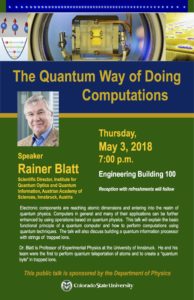
Written by Julia Trowbridge
Rainer Blatt, a professor at the Institute for Experimental Physics at the University of Innsbruck in Austria, will be giving a public lecture at 7 p.m. on May 3 in the 100 Auditorium of the Engineering Building at Colorado State University.
Blatt’s lecture, titled “The Quantum Way of Doing Computations,” will cover his research on quantum computers, which could work much faster than regular computers and could be a prevalent tool in the next 10 to 20 years. His lecture will be geared for a general audience.
“Quantum computation, from a technical point, is almost unavoidable,” said Siu Au Lee, a CSU physics professor in the College of Natural Sciences, on the importance of this topic. “But also, it’s getting a lot of publicity right now. Google is interested in it, Microsoft is interested it.”
The most popular applications for these quantum computers is national and internet security. Currently, information like passwords and bank accounts are secured by an algorithm that presents a very large number that can only be factored into two large prime numbers. The only way for a classical computer to crack the code is to try every combination, but a quantum computer could add a higher level of security by creating even more complex numbers.
“Internet security is based on numbers too long for you to find a code,” Au Lee said. “So the quantum computer has an algorithm that can actually speed up the amount of time it takes to factor by a huge [amount of time].”
Moving beyond Moore’s
In 1965, cofounder of Intel Gordon Moore noticed a trend in technology, which is now referred to as Moore’s law. Moore’s law states that the number of transistors per square inch has doubled every year since their invention – and will continue to do so in the future. This trend can be seen in the decreasing size of technology: from computers the size of entire rooms to handheld smartphones.
Physically, it is impossible for this trend to continue indefinitely in the way we currently make computer chips, because when this technology gets to such a small level, the atoms start following the rules of quantum physics that aren’t observed in larger structures.
“When everything gets smaller, the rules aren’t the same,” said Joseph Zadrozny, an assistant professor of chemistry at CSU. “That means we can’t design chips in the same way, and we can’t keep following the idea that if things keep shrinking they’ll work the same.”
For regular computers, each bit either has a spin up or down, correlating to a 1 or 0 in the computer’s language of binary. Instead of regular bits, quantum computers use quantum bits, which have a superposition of being 0 or 1 at the same time. This phenomenon has also been conceptualized by the idea of Schrodinger’s cat, where the cat is both alive and dead at the same time.
Because the quantum bit has this superposition, it can hold significantly more information than a regular bit. This allows the computer to work much faster, because the quantum computer is testing all the possibilities at the same time.
There are many different types of materials that can have quantum bits. Blatt’s research focuses on using trapped ions as the quantum bits. In this arrangement, ions are “trapped” in an electric field, and the information can be controlled by light. The difficult aspect of this type of quantum bit is making all of the quantum bits communicate, or coupling them.
Blatt and his research team were the first people to create a quantum computer that used trapped ions. They have made a computer with 20 trapped ions, which is the current record of ions. When coupling more and more quantum bits together, the amount of information that can be stored grows exponentially compared to a regular bit.
With quantum computing, Zadrozny said, “you’re getting enormously more bang for your buck.”
Blatt, leading the way in quantum computing research, has and continues to influence the future of computers. He also serves as scientific director of the Institute for Quantum Optics and Quantum Information of the Austrian Academy of Sciences. His public talk will cover more about quantum computing and how it could impact technology in 10 to 20 years.